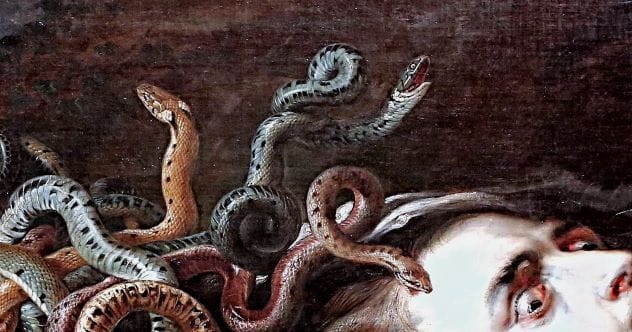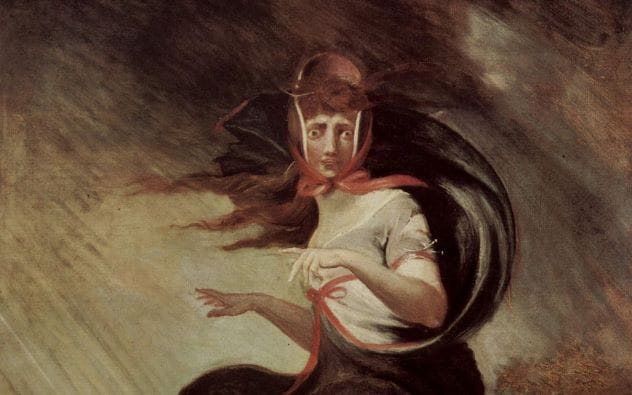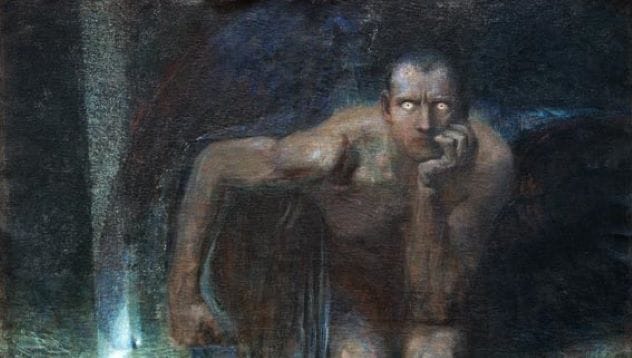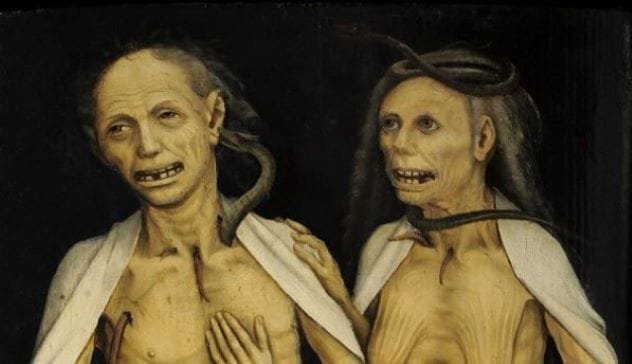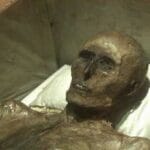Art isn’t always sunshine and rainbows. Sometimes, it stares right into the abyss, reflecting our deepest fears. Get ready to explore some masterpieces that are more nightmare than dream, creations so potent they’ll stick with you long after you’ve looked away. These artists dared to explore the unsettling, the tragic, and the downright terrifying. As Aristotle once said, “The aim of art is to represent not the outward appearance of things, but their inward significance.” Keep that in mind as you delve into this list – you might just lose some sleep.
10 Mad Kate – Heinrich Füssli (1806, Oil)

There’s something deeply unsettling when things aren’t quite as they should be. Heinrich Füssli’s Mad Kate perfectly captures this feeling. If you observe the painting from the bottom up, you might initially expect a gentle lady in a serene setting. The soft blue sky and hints of greenery suggest a peaceful day. But then, your eyes meet hers.
Her wild stare, with pupils askew, combined with her untamed hair and a cape that flows towards a suddenly dark and stormy sky, is jarring. The title itself, Mad Kate, confirms your unease. This painting taps into two primal fears: the loss of one’s own sanity and the horror of confronting the utterly unexpected. Few would volunteer to meet Mad Kate alone in the wilderness.
9 Drawings by Abused Children – (Tragically) Ongoing, Mixed Media
The innocence of a child is a precious thing. When that innocence is shattered by abuse, it’s a crime of unimaginable horror. Often, children express their trauma through art, turning a simple drawing into a heartbreaking window into their suffering.
Instead of happy stick figures and sunny skies, their drawings might feature houses without doors or windows, symbolizing a lack of escape. Abusive figures might be drawn with monstrously large, sharp teeth, or elongated, grasping hands, while the child might draw themselves without arms. These aren’t ‘artworks’ in the traditional sense, but they are profoundly horrifying. They are tragic expressions, yet also vital clues that can help bring perpetrators to justice and protect vulnerable children.
8 Untitled – Zdzislaw Beksinski (1975, Oil)
Polish artist Zdzislaw Beksinski has been aptly called “The Nightmare Artist.” Most of his works, typically untitled, drag the viewer into desolate, surreal landscapes populated by grotesque figures and eldritch horrors. The selected piece is a prime example of his spine-chilling vision.
His canvases are filled with twisted, agonized forms and demonic entities that seem to crawl out from the deepest recesses of our collective unconscious. Looking at his work, you can’t help but feel a sense of dread, a fear that these painted nightmares could somehow cross over into our reality. These are definitely not the images you want in your head before trying to sleep.
7 Gas – Edward Hopper (1940, Oil)
Edward Hopper was a master of creating mood. In Gas, he evokes an overwhelming sense of foreboding from an ordinary scene: a gas station at dusk. While it’s a bright, outdoor setting, unlike many of his darker, interior scenes, there’s an undeniable creepiness infused into the canvas.
The painting feels like a still moment before something terrible happens. Is it a depiction of Purgatory? Is a murder about to occur, or a natural disaster imminent? The lone attendant and the encroaching darkness of the woods create an atmosphere thick with unease. It’s the kind of place you’d expect to find in a slasher film, just before things go horribly wrong.
6 This Is Worse – Francisco Goya (1815, Drypoint)
Francisco Goya’s series The Disasters of War offers an unflinching look at the horrors of conflict. Among these, This is Worse stands out as particularly visceral and shocking. Goya didn’t shy away from depicting the brutal realities he witnessed or heard about during the Peninsular War.
This drypoint etching shows a mutilated victim of war, impaled on a tree, his body treated with utter disregard. His head is turned towards the viewer, mouth agape in a silent scream, while in the background, French soldiers continue their atrocities. The scene is based on a real event of retaliation. If you want to understand the true, raw horror of war without experiencing it firsthand, Goya’s work brings you terrifyingly close. Be warned, it’s not for the faint of heart.
5 The Various Paintings Concerning John the Baptist’s Beheading – Caravaggio (1607-1610, Oils)
Caravaggio was a genius, a master of light and shadow, and a man with a notoriously violent temper. His paintings depicting the beheading of John the Baptist are a testament to his ability to be simultaneously horrifying and breathtakingly beautiful. These works are stunningly rendered, yet chillingly gruesome.
He brings the biblical tale to life with a raw intensity that words cannot match. The divine and the violent intertwine, creating scenes that are as captivating as they are disturbing. Knowing Caravaggio’s own life of brawls and murder, one can see a reflection of his turbulent spirit in these powerful, unsettling masterpieces.
4 Lucifer – Franz Von Stuck (1891, Oil)

The devil has often been sanitized or even romanticized in modern pop culture. Franz Von Stuck’s Lucifer, however, forces us to confront a more ancient and terrifying concept of this fallen angel. The painting is dark, but Lucifer’s eyes burn brightly, fixing the viewer with an unnervingly direct gaze.
Imagine being him: cast out of Heaven, forever an adversary, doomed to an eternity of loss and misunderstanding his own nature. Those eyes seem to radiate madness, futility, and a chilling invitation. The longer you look, the more the old, fearsome idea of the devil re-emerges, tempting you to ponder the inherent injustice of existence alongside him.
3 Head of Medusa – Peter Paul Rubens (1617–1618, Oil)
While Caravaggio also famously depicted Medusa’s severed head, Peter Paul Rubens’ version takes the horror to another level. Just look at those snakes! Writhing, venomous, and so numerous, they make your skin crawl even if you don’t have a phobia of them. Blood drips from the severed neck, magically forming into new, smaller snakes.
The sheer gruesomeness of this Gorgon’s head is startling. Adding to the unease are other creatures like spiders and a salamander in the scene. Imagine Perseus having to handle this venomous, gory mess. Would you dare go anywhere near it? Rubens brings the ancient myth to life with a dramatic flair that is both fascinating and repellent.
2 Gin Lane – William Hogarth (1751, Etching and Engraving)
William Hogarth’s Gin Lane is a powerful piece of social commentary, a stark warning about the ruinous effects of cheap gin in 18th-century London. It’s not a preachy sermon, but a horrifying depiction of degradation, chaos, and despair. Looking at it before a night out might make you reconsider those extra shots.
The scene is filled with death, decay, and debauchery. The central, most disturbing image is a gin-addled, syphilitic mother, oblivious as her baby falls from her arms to its likely death below. This imagery was rooted in real-life tragedies of the era. Gin Lane, contrasted with its companion piece Beer Street (which depicted happy, healthy Londoners), aimed to show gin as a corrupting foreign evil, and its message remains chillingly effective.
1 The Dead Lovers (aka The Rotting Pair) – Unnamed Master from Swabia/Upper Rhine (c. 1470, Oil)

Memento Mori – “remember that you have to die” – was a common theme in European art, reminding viewers of their mortality. This piece by an unknown German master takes that reminder to an extreme, visceral level. There are no subtle skulls hidden in the corner here; this painting slaps you in the face with the reality of death.
Once the reverse side of a portrait of a handsome young married couple, this painting shows that same pair as rotting corpses. Their decaying forms are being ravaged by snakes, frogs, and other scavenging creatures. Yet, even in their horrific state, the couple maintains a semblance of closeness, perhaps suggesting that love endures beyond death. Still, gifting a newlywed couple a painting of themselves as decaying zombies is quite a statement, even if it’s a profound one.
From the unsettling gaze of Mad Kate to the graphic decay of The Dead Lovers, these artworks prove that beauty isn’t the only aim of art. They confront us with fear, madness, and the unsettling realities of life and death. These pieces aren’t just images; they’re experiences that challenge us and remind us of the power art holds to evoke our deepest emotions.
Which of these horrifying artworks chilled you to the bone? Share your thoughts in the comments below!


